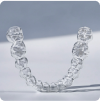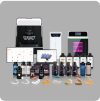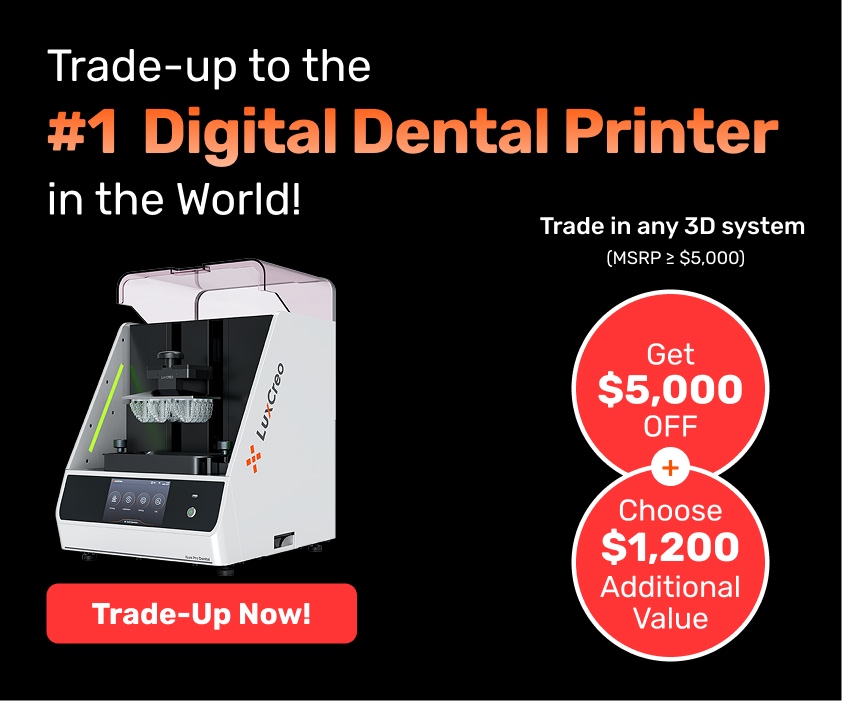
Five Benefits of Using a 3D Printing Dental Lab
Partnerships between dental labs and practices are essential for modern dentistry. Dentists rely on dental labs to fabricate their diagnostic models and oral devices. Requiring the use of large machines, making crowns, bridges, retainers, and other dental appliances is a time-consuming process. By partnering with a dental lab, practices can outsource labor-intensive tasks in device creation and focus on patient service.
Today, lab/practice partnerships are more beneficial with the accessibility of 3D printers. Advanced 3D printing solutions produce devices with a faster turnaround time than traditional and even legacy 3D printing methods. The innovative resins and resin-printing techniques used by modern 3D printers offer industry-leading strength, accuracy, and transparency leading to better end products.
Reliable, quick, and cost-effective, 3D printing dental labs help practices provide excellent customer service.

How Does 3D Printing Support Digitalization of Dental Labs?
3D printing technology optimizes nearly every step of dental appliance production, from leveraging patient oral impressions to the final stages of post-processing. Each element of a 3D printing solution—hardware, software, and materials—works together to accelerate device turnaround time, increase accuracy, and enhance the product’s visual and mechanical properties.
Although workflows will slightly vary depending on the application, 3D printing dental labs will generally perform the following steps to produce a device:
- Scan: 3D printers manufacture devices based on 3D digital oral impressions. Dentists create digital impressions by scanning patients’ mouths with an intraoral scanner. The process is faster, more accurate, and more comfortable for the patient than traditional dental molds.
- Design: After capturing the digital oral impression, the dentist digitally sends the scan to the lab. A lab technician converts the scan into a digital dental model. Powerful 3D printing software like LuxDental allows technicians to automatically generate models with precise margin lines and support structures creating 3D printable dental models at a rapid pace.
- Print: Once the design phase is complete, the technician prepares the printer by installing a resin-filled tank and build platform. After sending the print file to the printer, the 3D printer begins producing the dental appliance by precisely layering material from the ground up. The additive manufacturing process is fast, accurate, and results in a strong oral device. To increase production throughput, LuxDental’s advanced nesting functions allow technicians to manufacture multiple devices in a single batch, shortening the turnaround time.
- Post-Process: Technicians need to perform post-processing steps such as washing, curing, buffing, and polishing to make an oral device suitable for use. With legacy 3D printing technology, CNC machining, or conventional production, post-processing could take hours to complete. Newer 3D dental printers like ‘Lux 3+ Dental’ and ‘iLux Pro Dental’ significantly reduce post-processing time by directly 3D printing clear devices with a smooth surface finish.
Five Benefits of Partnering with a 3D Printing Dental Lab
Modern 3D printing solutions improve the daily operations of dental labs. Through operational improvements, practices can receive better devices with a faster turnaround time. The ways in which 3D printing advance dental labs are:
1. Faster Speed
3D printing workflows eliminate the time-consuming steps in dental device production. Appliances like dental models, aligners, and surgical guides all traditionally require a high degree of hands-on work. 3D printers eliminate artisanal device production by fully digitalizing the workflow, shortening turnaround from days to hours.
2. High Precision / Accuracy
Dental appliances must be accurate to function correctly. 3D printers ensure a high level of precision by providing:
- Software that allows technicians to completely control interior and exterior dimensions, boosting overall accuracy and eliminating drilling steps.
- High-resolution printing that raises dimensional accuracy and creates a true-to-design end product.
- 3D-printable resins that have significantly less shrinkage during printing and curing – preventing device distortion and maintaining high accuracy.
3. High-Performance Materials
The latest 3D printers are compatible with some of the best dental materials on the market. The robust mechanical properties allow the end products to last long, fit well, and operate as intended. Recent advancements in dental resins and resin-printing techniques now support the printing of transparent materials for clear aligners.
4. Support Wide Range of Applications
3D printers are versatile machines that can produce a wide range of devices. Powered by sophisticated software, machine learning, and access to a diverse resin portfolio, 3D printers produce all of the most common dental applications in a tight timeframe.
Possible applications include:
- Trays
- Models
- Surgical Guides
- Dentures
- Orthodontic Splints
- Crowns and Bridges
- Aligners
5. Reduced Post-Processing
3D-printed oral devices require fewer post-processing steps compared to appliances made with conventional methods. While the appliances still need to be washed, cured, and buffed, 3D printers significantly reduce post-processing time. For example, Lux 3+ Dental 3D printers -produce a batch of aligners in less than 30 minutes and reduce the wash, cure, buff steps to minutes. Reduced post-processing allows practices to receive their device orders and produce the devices in a fast, reliable manner.
Hybrid Delivery Model: Practices and Labs Discover the Benefits of LuxCreo’s 3D Printers
Outsourcing to a lab, dental practices to obtain high-quality oral devices. With 3D printing, dental labs produce appliances faster without sacrificing strength or accuracy. However, outsourcing isn’t the only way for dentists to access the benefits of 3D printing.
To make oral device production even more accessible, LuxCreo offers a line of desktop 3D printers. These compact printers are simple to operate and can easily fit into existing dental production workflows. For individual practices, consider iLux Pro and LuxaDent.
- Benefits of iLux Pro: The iLux Pro can produce all of the same applications as an industrial printer like Lux 3+Dental. Compact and with an accessible price point, iLux Pro empowers dentists to produce high-quality devices at their practice. With in-house production, dental practitioners can provide customers with appliances within a short timeframe, even offering same-day turnaround (work queue permitting).
- Benefits of LuxaDent: More affordable than the iLux Pro, LuxaDent specializes in creating dental models and surgical guides. Fast and accurate, LuxaDent is compatible with a proprietary suite of dental materials, allowing dentists to make everything from crowns to nightguards in-house. LuxaDent does not print clear appliances, so post-processing is longer than devices made with the iLux Pro.
With LuxCreo desktop and industrialized dental 3D printers, practices can adopt a hybrid delivery model where practices make the most time-sensitive devices in-house—achieving same-day delivery and outsource the remaining production to a dental lab. Dental practices that are not ready to bring 3D printing in-house can partner with a dental lab outfitted with LuxCreo products, gaining the benefits of 3D printing without investing in new hardware.
To learn more about the benefits of using a 3D printing dental lab, or to inquire about LuxCreo’s comprehensive printing solutions, visit our contact page or call (650) 336-0888.
Join Us
By subscribing, you will receive exclusive access to our latest news, updates, and special offers.
Follow Us
Featured Products

4D Aligner™
First Smart ActiveMemory™
Aligner

iLux Pro Dental Solution
Ultimate 1-Click Dental
Application Solution

LuxCloud Dental
Your One-stop Digital Dentistry
Platform

